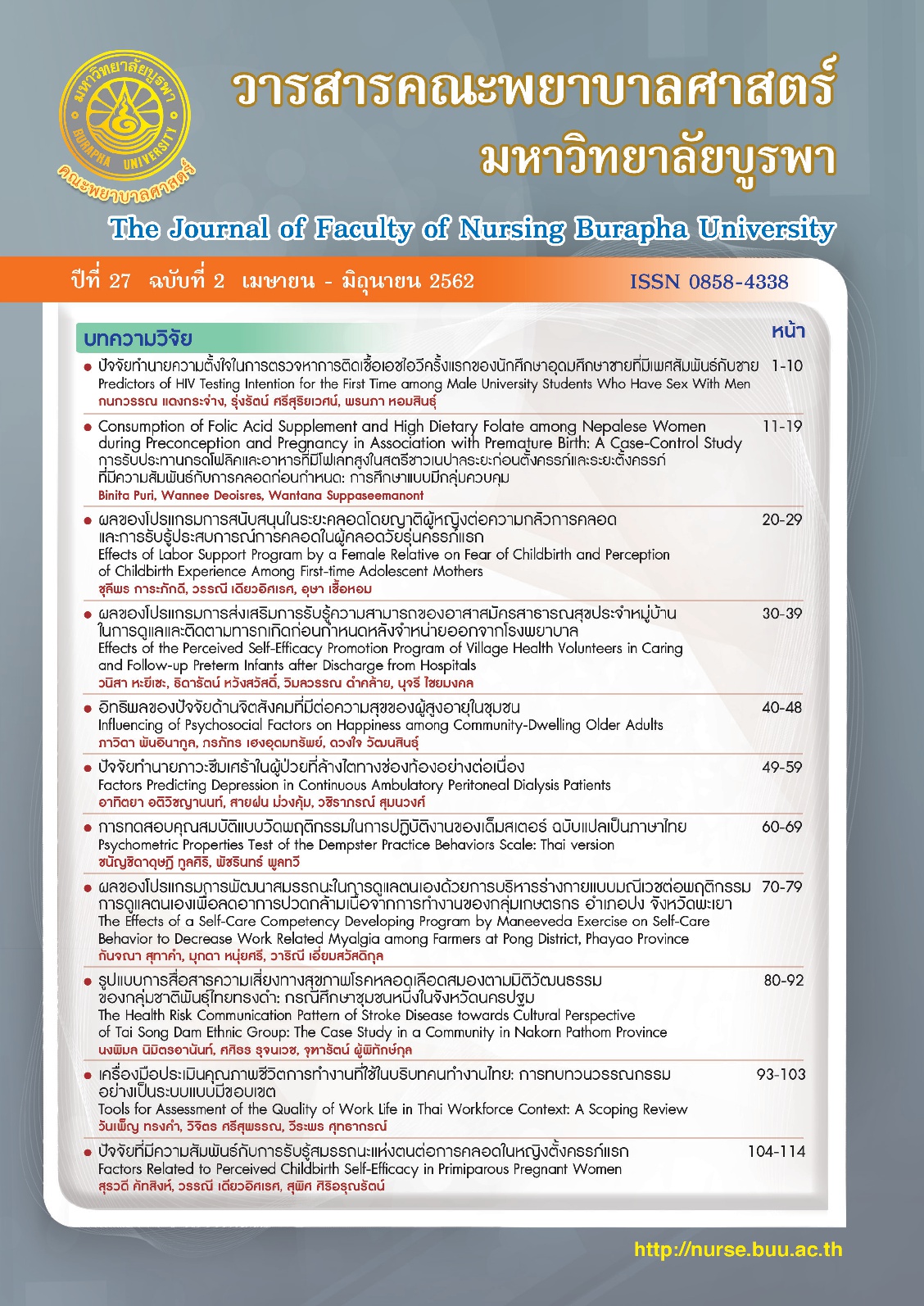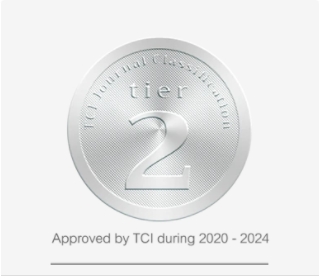ปัจจัยทำนายความตั้งใจในการตรวจหาการติดเชื้อเอชไอวีครั้งแรกของนักศึกษาอุดมศึกษาชายที่มีเพศสัมพันธ์กับชาย
คำสำคัญ:
ชายที่มีเพศสัมพันธ์กับชาย, ความตั้งใจ, การตรวจหาการติดเชื้อเอชไอวีบทคัดย่อ
บทคัดย่อ การศึกษาแบบหาความสัมพันธ์เชิงทำนายนี้ มีวัตถุประสงค์เพื่อศึกษาปัจจัยทำนายความตั้งใจในการตรวจหาการติดเชื้อเอชไอวีครั้งแรกของนักศึกษาอุดมศึกษาชายที่มีเพศสัมพันธ์กับชาย กลุ่มตัวอย่างจำนวน 107 คน เป็นนักศึกษาชายที่มีเพศสัมพันธ์กับชายที่กำลังศึกษาในสถาบันอุดมศึกษา ในภาคตะวันออก คัดเลือกแบบสะดวก เครื่องมือวิจัยเป็นแบบสอบถาม 6 ชุด ได้แก่ ข้อมูลทั่วไปและพฤติกรรมเสี่ยงทางเพศ การรับรู้รูปแบบบริการตรวจหาการติดเชื้อเอชไอวี เจตคติต่อการตรวจหาการติดเชื้อเอชไอวี การคล้อยตามกลุ่มอ้างอิงต่อการตรวจหาการติดเชื้อเอชไอวี การรับรู้ความสามารถในการควบคุมปัจจัยต่อการเข้ารับการตรวจหาการติดเชื้อเอชไอวี และความตั้งใจในการตรวจหาการติดเชื้อเอชไอวี มีค่าความเชื่อมั่นระหว่าง .72 – .80 วิเคราะห์ข้อมูลโดยสถิติวิเคราะห์ถดถอยพหุคูณ
ผลการศึกษาพบว่าเจตคติต่อการตรวจหาการติดเชื้อเอชไอวี (β =.209) การคล้อยตามกลุ่มอ้างอิง (β =.408) ความสามารถแห่งตนในการควบคุมปัจจัย (β = .361) และการรับรู้รูปแบบการบริการ (β =.187) สามารถร่วมทำนายความตั้งใจต่อการติดเชื้อเอชไอวีครั้งแรก ได้ร้อยละ 29.2 อย่างมีนัยสำคัญทางสถิติ (R2adj= .257, F Change = 8.34, p < .001) ผลการวิจัยนี้ให้ข้อเสนอแนะว่า การส่งเสริมให้เยาวชนชายที่มีเพศสัมพันธ์กับชายให้มีความตั้งใจในการเข้ารับการตรวจหาการติดเชื้อเอชไอวี ควรเสริมการสร้างเจตคติเชิงบวกต่อการตรวจหาการติดเชื้อเอชไอวี สร้างความมั่นใจในตนเอง สนับสนุนบทบาทของสมาชิกในครอบครัวและเพื่อน รวมทั้งการพัฒนารูปแบบบริการให้เข้าถึงได้
References
Ajzen, I. (1991). The theory of planned behavior. Organizational Behavior and Human Decision Processes, 50(2), 179-211.
Bandura, A. (1997). Self-efficacy: The exercise of control. New York: W. H. Freeman and Company.
Bureau of AIDS, TB and STIs Official, Publication of the Department of Disease Control, Ministry of Public Health. (2015). Situation of AIDS patients and HIV in Thailand, 2015. Retrieved from http://aidssti.ddc.moph.go.th/contents/view/7. [In Thai]
Bureau of Reproductive Health. (2015). Adolescent and youth reproductive health. Retrieved from http://rh.anamai.moph.go.th/ [In Thai]
Chamniyom, A., Krungkraipetch, N., & Junprasert, S. (2017). Factors predicting intention to voluntary HIV screening test among male prisoners in Rison seventh territory. The Journal of Faculty of Nursing, Burapha University, 25(2), 57-68. [In Thai]
Chonburi Provincial Public Health Office. (2015). HIV testing services in Chonburi. Retrieved from http://www.cbo.moph.go.th/cbo/ [In Thai]
Emraja, C. (2014). Inequity in registration of civil partnership under the draft civil partnership registration act. Retrieved from http://libdcms.nida.ac.th/thesis6/2557/b190070.pdf. [In Thai]
Francis, J., Eccles, M. P., Johnston, M., Walker, A. E., Grimshaw, J. M., Foy, R., et al. (2004). Construction questionnaires based on the theory of planned behaviors: A manual for health services researchers. Newcastle upon Tyne, UK: Centre for Health Services Research, University of Newcastle upon Tyne.
Jaigaa, P. (2014). VCT Chiang Kham. Retrieved from http://aidssti.ddc.moph.go.th/researchs/ view/2860 [In Thai]
Jantarmanee, P., & Jantarmanee, S. (2016). A prevalence survey of HIV and sexually transmitted infection among men who have sex with men (MSM), Thailand: Venue day time sampling (VDTS) and respondent driven sampling (RDS). Disease Control Journal, 42(4), 269-279. [In Thai]
Kendall, C., Kerr, L. R., Gondim, R. C., Werneck, G. L., Macena, R. H., Pontes, M. K., et al. (2008). An empirical comparison of respondent-driven sampling, time location sampling, and snowball sampling for behavioral surveillance in men who have sex with men, Fortaleza, Brazil. AIDS and Behavior Journal, 12(4), 97–104.
Ketsingha, W. (1995). Mean and Interpretation. Journal of Education Research, 18(3), 8-11.
[In Thai]
Lau, J. T. F., Gu, J., Tsui, H. Y., & Wang, Z. (2013). Prevalence and associated factors of intention
to participate In HIV voluntary counseling and testing for the firth time among men who have sex with men in Hong Kong, China. Preventive Medicine, 57(6), 813-818.
Phatisena, T. (2011). Empowerment model of peer leaders for AIDS preventive sexual risk behavior among students, Nakhon Ratchasima Rajabhat University. Khon Kaen University Research Journal, 16(7), 864-873.
Polit, D. F., & Beck, C. T. (2008). Nursing research: Generating and assessing evidence for nursing practice (8th ed.). Philadephia: Lippincott Williams & Wilkins.
Pongam-Phai, B., Songwathana, P., & Boonyasopun, U. (2009). Factors predicting intention to attend HIV screening services among pregnant women’s spouses. Thai Journal of Nursing Council, 24(4), 70-82. [In Thai]
Powwattana, A., Auemaneekul, N., & Lagampan, S. (2017). The model of risk behavior for sexual prevention of adolescent. Bangkok: Protexts.com. [In Thai]
Shin, S. R., Kang, H. S., & Moneyham, L. (2007). Characteristics of individuals seeking voluntary counseling and testing for HIV infection in South Korea. Journal of the Association of Nurses in AIDS Care, 18(5), 24-33.
Stanley, L., David, W. H., Janelle, K., & Stephen, K. L. (1990). Adequacy of sample size in health studies. Chichester: John Wiley & Sons.
Thepthien, B., Srivanichakorn, S., Apipornchaikul, K., Subhaluksuksakorn, P., & Prakongsai, P.
(2015). Factors contributing to the voluntary counseling and HIV testing for persons at
risk of HIV infection in Thailand. Journal of Medicine and Health Sciences, 22(1), 10-20.
[In Thai]





